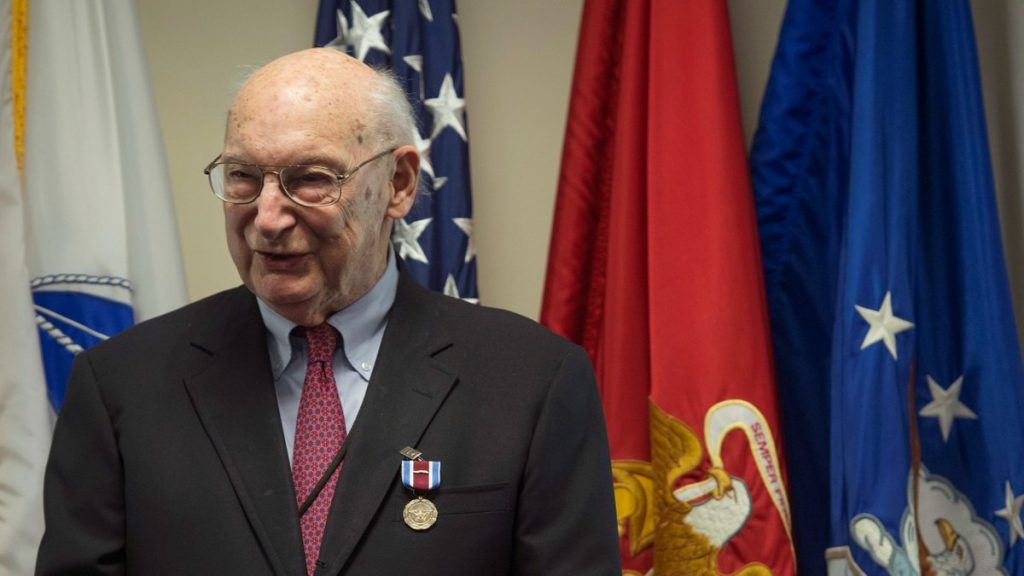By ANDREW KREPINEVICH
Last year while in Japan for a meeting with senior defense and military leaders, the question most often posed to me was, “How is Yoda?”
The questions were in reference to the nickname given to Andrew Marshall, arguably the foremost defense strategist of the past sixty years, who passed away this week at the age of 97. He is best known for his 42-year tenure as head of the Pentagon’s innocuously named Office of Net Assessment, the defense secretary’s private “think tank” that Marshall formed and led under every president from Richard Nixon to Barack Obama.
Marshall himself disliked being compared with the Star Wars character, but the name stuck, and for good reason. Like Yoda, Marshall was quiet and unassuming, and spoke sparingly. When he did, his observations could seem inscrutable to many who struggled in their efforts to plumb the depths of “net assessment,” a powerful strategic planning methodology Marshall developed and refined over the course of 60 years of public service.
During this time he mentored and trained a group of defense notables, who referred to themselves as graduates of “St Andrew’s Prep.” Among their numbers were a chief Middle East peace negotiator, a secretary of the Air Force, Ivy League professors, and a vice chairman of the Joint Chiefs of Staff.
Marshall is often referred to by defense cognoscenti as “the most famous person you’ve never heard of.” While still in his twenties, he had already spent time working on Nobel Prize-winning physicist Enrico Fermi’s cyclotron and as the bridge partner of another Nobel winner, economist Kenneth Arrow.
Marshall, along with titan strategists like Herman Kahn and Albert Wohlstetter, was one of the “Wizards of Armageddon” at the RAND Corporation during its golden era in the 1950s. Although content to work in the background, according to one colleague it was clearly understood that Marshall was “first among equals.”
Indeed, it was Marshall who suggested to Roberta Wohlstetter the focus for her classic book, Pearl Harbor: Warning and Decision. His path-breaking work on the role that organizations play in decision-making led to Graham Allison’s seminal work, Essence of Decision.
Aside from his towering intellect, Marshall’s success was rooted in his intense desire and abiding curiosity to understand what is really happening or, more simply, the truth. There was also his intellectual honesty, refreshing in an age where so many are driven by agendas and seek “ammunition” to support their views rather than insights to better understand a complex world. Another key to Marshall’s success—and to his enduring value to presidents of both political parties—was his willingness to reconsider his beliefs when they conflicted with the facts, and to challenge the conventional wisdom when it became apparent that it did not reflect the reality of the true state of affairs.
Marshall’s dedication to rigorous analysis and his moral courage never shown brighter than when he challenged the CIA over its assessment of the Soviet Union’s economy and defense effort in the 1970s. Marshall argued persuasively and successfully that the Russian economy was not as strong as the intelligence community believed, and that the Soviet military buildup was exerting enormous strain on their economy that could not be sustained over time. Simply put, the Soviet Union was not 10 feet tall, but rather had feet of clay. If the United States persevered in its defense of the Free World, Marshall concluded, time was on its side, not Russia’s.
Indeed, Marshall’s remarkable ability to anticipate shifts in the strategic environment became legendary over time. Over 30 years ago, in the midst of arms control negotiations with the Russians, in a memo to senior Pentagon officials, Marshall explained how China, not the Soviet Union, would emerge over the next few decades as the major strategic rival to the United States.
While it’s become fashionable in some circles today to assert that thinking about war—indeed, even thinking about how to avoid it—makes one a warmonger, Marshall was anything but. He was one of a dwindling number of people who witnessed a nuclear weapon test. When asked about the experience, Marshall would emphasize the weapon’s power—the flash so brilliant it felt like being inside the Sun itself—and its horror.
He felt it would be useful to have the world’s leaders witness such a test every so often, so they could better understand the folly of war. And when his travels took him to Europe, which they often did, Marshall would try to visit the cemeteries at Normandy to pay respect to those of his generation who had not survived to see the better world they made possible through their sacrifice. To a great extent his public service was driven by a desire to ensure their sacrifice was not in vain.
Toward the end of his life, Marshall expressed his fear that Americans may be forgetting how fragile peace is, and how hard it has been historically to avoid war. In sharing his fears, Marshall would recall the most emotional public experience of his lifetime. It occurred at his high school graduation in 1939, only a few months before general war would break out in Europe. It had been only a generation since the last world war, and parents at that time knew from personal experience that, if another war came, casualties would be enormous, and few families would be spared. Normally, graduations are a time of celebration and great expectations. The mood at this graduation, however, was subdued. Parents sat somberly in their seats. Many wept.
Marshall dedicated his life in an effort to ensure that such a scene would never be repeated. It never was—not on his watch. But the price of peace requires eternal vigilance. Through their hard work and sacrifice, Marshall and the “greatest generation” gifted the United States a long peace. But the question remains: Are today’s Americans willing to make the sacrifices necessary to keep it?

No comments:
Post a Comment